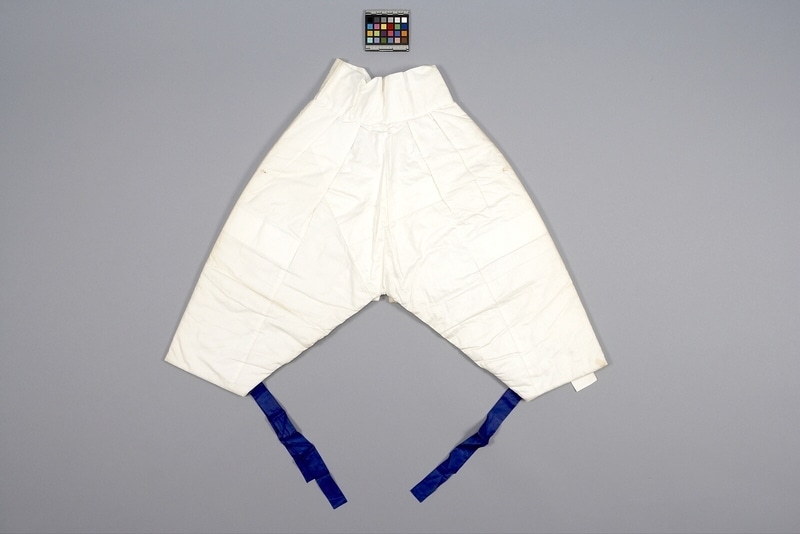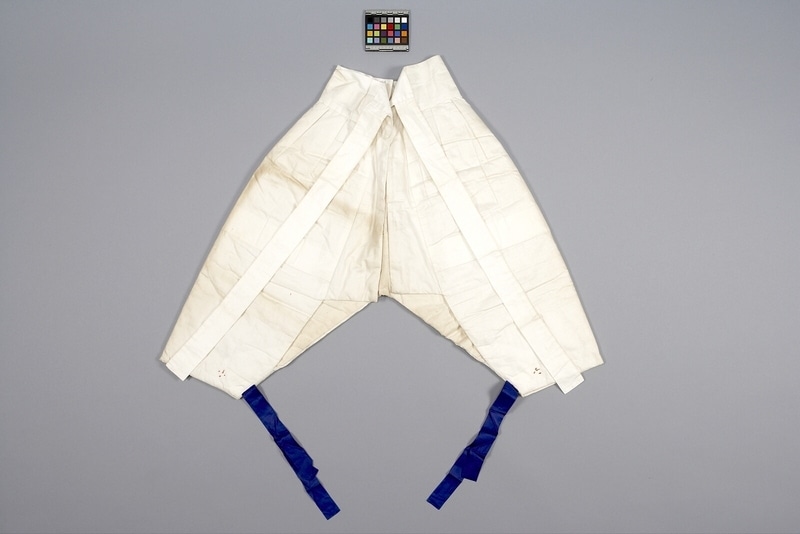Underwear Item Number: Ed1.301 from the MOA: University of British Columbia


Description
Padded under-trousers of fine white cotton fabric, lined with coarser off-white fabric. Pants are angled out from the pleated waistband to the ankles. Waistband opening at the back, attached to narrower long ties. Pleats face towards centre seams, front and back. Flared panels are attached to each side of the back opening, which is carried on in the open inner leg seam, sewed together just above the ankle. Dark blue ribbons of shiny silk are attached to each inner leg seam at the bottom. There is a horizontal seam in the outer white fabric at about knee level.
History Of Use
Worn next to the skin, as an undergarment, by a very small young woman, or a child. The ribbon ties were used by children. Such underwear before this time had a crotch slit that continued to the front, but it was simplified during the modernization of Korea and the slit limited to the back. Later, shoulder straps were added. The additional flaps at the back were to ensure that the skin was covered, which was very important during the Chosun Dynasty. The flaps are called “Mit-ba-dae”. Only women’s under-trousers had the back slit; men’s did not. Men also did not wear as many layers of underwear as women did. The ribbon ties were to prevent them from slipping down when the wearer went to the toilet. Underwear was and is boiled as part of the laundry process. Women wore the following layers of lower-body underwear: loincloth that passed between the legs and fastened front and back to a waistband (Da-ri-sok-got); , wide, straight-legged under-trousers with a side opening with ties and no crotch slit (Sok-sok-got); back- or side-opening under-trousers tapering to the ankles, with flaps at the crotch opening (Sok-ba-ji); wide , straight-legged under-trousers with no crotch slit (Dan-sok-got); under-skirt (Sok-chima); and outer skirt (chima). Many layers of underwear were important to add bulk for elegance, and to protect their virginity. Underwear was tied below the wearer’s breasts, and extended to the back of her foot. Prostitutes might have intentionally show their ankles. White was the traditional colour worn by all people except the upper classes. Use of white clothing in Korea began in the Ming Dynasty, about five hundred years ago.
Iconographic Meaning
Blue ties signify that the wearer likely was a child.
Specific Techniques
Sewn entirely by hand with concealed seams; sewn inside out and then turned through a small hole that was left unsewn. The batting was stitched in place and possibly secured with paste. Body of pants was pleated onto waistband.
Item History
- Made in Korea during 1930
- Collected during 1983
- Owned by Hi Soon Kim before January 18, 1984
- Received from Hi Soon Kim (Seller) and Unknown (Funding source) on January 18, 1984
What
- Name
- Underwear
- Identification Number
- Ed1.301
- Type of Item
- underwear
- Material
- cotton fibre, ramie fibre, dye, paste adhesive ? and silk fibre
- Manufacturing Technique
- spun, machine stitched, woven, dyed, cut, sewn, turned, pleated and pasted ?
- Overall
- height 65.0 cm, width 79.5 cm
Who
- Culture
- Korean
- Previous Owner
- Hi Soon Kim
- Received from
- Hi Soon Kim (Seller) and Unknown (Funding source)
Where
- Holding Institution
- MOA: University of British Columbia
- Made in
- Korea
When
- Creation Date
- during 1930
- Collection Date
- during 1983
- Ownership Date
- before January 18, 1984
- Acquisition Date
- on January 18, 1984
Other
- Item Classes
- textiles
- Condition
- good
- Accession Number
- 0939/0008